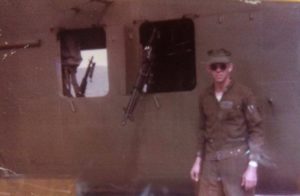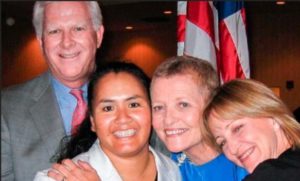
Part I: Sid’s Story
Silent for many decades, Vietnam veterans tell their stories in different ways, through books, blogs, articles, and music. One veteran, Sid Orr, found his voice by writing Vietnam ballads, telling the emotional story through poignant lyrics reflecting his and others’ experiences during their time “in country.”
Sid grew up in rural Missouri, and like many “farm boys” of the era, he enlisted in the Marine Corps at age 18 after receiving his draft card. He served in the Marine Corps for four years, the last of which was in Vietnam as a helicopter gunner stationed in Phu Bai, just south of the DMZ.
After returning from Vietnam, he made his way to Georgia and joined the Georgia Air National Guard serving another 30 years!
Sid is a humble and thoughtful man, and his war experiences affected him deeply, staying with him through the decades. Like other Vietnam veterans, he felt a subconscious anger and shame that permeated his soul. And like others, he didn’t talk about it.
In the song, “Powder Blue” from his first CD, he describes how the war is never far away:
I hear the mortars on the hillside
Smoke covers my morning dew
But the damn war is never behind me
It colors all that I do
Powder blue
Returning from Vietnam, veterans like Sid faced many challenges. Unlike other wars, they went to war alone – not as part of a unit. They returned alone having to reintegrate into a society where many demonized those who fought “in country.” Friends, family members, and others who wanted to help didn’t understand. They couldn’t possibly. Sid says it best in his song, “He Can’t Go Back Home From Vietnam”:
He can’t go back home from Vietnam
Ain’t nobody there will understand
They want their boy back home
But that boy, he’s long gone
They took fifteen years of his
Just paid him for one
Songwriting is A Passion, a calling
By the 1980s, Sid had what can only be described as a passion for songwriting, all kinds, but particularly country western and then bluegrass. The “three-chord poet” carried a notebook and a cassette recorder with him everywhere, even pulling off the highway to record his thoughts. During this time, the Vietnam songs kept “bugging” him – they had to be written.
Although they began as a personal cathartic experience, they evolved into a story Sid wanted to tell. The lyrics describe the action but convey so much more.
The Vietnam veteran and his family’s lives changed forever after he received his draft card. If a boy didn’t go to college, he had thirty days to decide to enlist or be drafted. From “You’ve Got Thirty Days:”
I was just 18
Figured out the score
Rich kids go to college
Poor kids go to war
Some things were not an option
Like running to Montreal
Didn’t think that way
We answered our nation’s call
Put your life on hold now
Tell your friends goodbye
You’ve got 30 days to decide
Fighting in Vietnam, the warrior faced death or worse. The Missing In Action (MIA) just disappeared. For their families, the war never ended.
In the “MIA Song: I’ll Be Right Back,” a recon patrol clears a place to dig in – one man goes out to set the perimeter and never returns.
Gonna leave my noisy helmet here
Gonna leave my belt and pack
The last thing the hero said
“Sarge, I’ll be right back.”
They never sent his helmet home.
Never sent his belt and pack.
The only remains were memories
To his hometown high school class
But they swore to God they won’t lose hope
They’ll hold out to the last
Because the promise that he made
“Hey, Mom, I’ll be right back.”
For the Vietnam vets who came home, the memories remain. As for the rest of us – there is a black granite wall that will not let us forget the 58,000+ warriors who made the ultimate sacrifice. From the song “As Long As The Black Granite Stands”:
He wore a helmet and heavy dark green vest
To protect his head and the best part of his chest
Chaplain told his men, that the vest won’t even start
To protect the wounded soldier’s heart
As long as the black granite stands
58,000 names man to man
Words of the chaplain come alive
Oh in our hearts our brothers never die
We’ll never let our brothers’ memories die
Recording Ain’t That Easy
Sid didn’t plan to make a CD, he just wanted to record demos of a few of his songs. He worked with local studios, singing and playing guitar to a piano accompaniment. After spending hours and hours on the time-consuming task of recording and editing tracks on reel-to-reel recording systems, they just didn’t sound good. Sid burned out on his songs – but he never quit writing, and wouldn’t or couldn’t let go of his Vietnam ballads.
From the mid-1990’s to 2010 recording had to take a back seat. As part of the Air National Guard, Sid “commuted” between Atlanta, GA area to Warner Robins Air Force Base in middle Georgia from 1994 to 1999. At the same time, he was taking education courses, eventually acquiring his teaching credentials. After retiring from the Georgia Air National Guard in 1999, he taught high school until he retired from education in 2010.
For the first time in over fifteen years, he had the time to devote to his songwriting, and to the Vietnam ballads that wouldn’t let him go – the time had come.
The First CD Is Born
Remembering his previous recording experience, Sid decided to go to Nashville, the “Home of Country Music,” with professional studio musicians and vocalists. He met Galen Breen at Gator Hole Studios, and the two discussed the ballads and how Sid wanted to convey his message. Sid returned home and prepared two songs a week for Galen to record. With Nashville studio musicians and the talent of 70’s country western singer, David Wills, the songs came to life in the 2013 CD release – Vietnam: The Journey.
After the CD’s release, Sid found it rewarding to receive positive feedback from friends, family, and fellow veterans who were “blown away,” or “in awe.” One veteran said he couldn’t stop listening to it – the songs touched him in ways he could not describe.
To be Continued…
In our next post, learn how Tunnel Rats Music came to be. How having like-minded and supportive people like Robin Daniel and Libby Wilson helped Sid move forward to write and produce the second CD – Vietnam: The Journey Continues.M
 stories provide an extraordinary opportunity for understanding and healing, which for decades, alluded those who served in Vietnam.
stories provide an extraordinary opportunity for understanding and healing, which for decades, alluded those who served in Vietnam. American soldier wanting to adopt Kathleen cut through the red tape and bureaucracy to do so. “Kathleen” made her way to the United States to live with her adopted family.
American soldier wanting to adopt Kathleen cut through the red tape and bureaucracy to do so. “Kathleen” made her way to the United States to live with her adopted family. “Kathleen,” her adoptive parents, and her children. They remain friends today.
“Kathleen,” her adoptive parents, and her children. They remain friends today.

